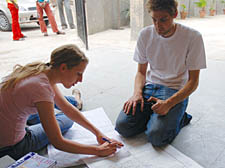|
|
 |
| |

Toni Fryer and Steve Choun working on the street map of the Ambedka Camp |
Pitch to save patchwork houses
Students travel to Delhi to create the first street map of ‘slum’ settlement under threat
AS night fell on the eve of the Hindu festival of Diwali, children let off bangers and fireworks, villagers prayed on their doorsteps by candlelight and welcomed students into their homes.
London Metropolitan University student Toni Fryer, 25, who lives in Torriano Avenue, Kentish Town, has just returned from a study trip in Delhi, India, with 25 other architecture undergraduates.
The students paid £800 for travel and board and spent two weeks mapping and surveying the unnamed streets of the Ambedka camp, a slum settlement in the Jilmil industrial estate, east of the Yamuna river.
The project was devised by Robert Barnes and Maurice Mitchell, tutors at the university, who teamed up with NGOs and entrepreneurs three years ago. Last year funding from Indian businessmen enabled a group of students to return to a slum in Agra to oversee the construction of an elaborate toilet and drainage system.
Ambedka’s first migrant agricultural families, forced to seek work in the city, began to build homes against the wall backing onto the surrounding tyre manufacturers, diamond and packaged food factories 20 years ago.
Although plans to bulldoze the colourful, ramshackle settlement – home to an estimated 1,000 families – have recently been averted, there is no guarantee for the future.
India’s state-of-the-art Metroline will instead skirt around the patchwork houses but the value of the land is likely to rocket, attracting the attention of developers and threatening the villagers with displacement.
“So far they have managed to save the settlement,” said Ms Fryer.
“By making it more official, the camp becomes more viable and has a greater chance of survival.”
On arrival, the students were greeted by crowds of curious people.
Ms Fryer said: “The whole time we were there we were surrounded by children, wanting to shake our hands, who then became our little guides protecting us from snakes and rabid dogs and the occasional drunk.”
In the narrow, dusty alleys, people wash out of buckets and children play with tyres beside piles of rubbish and human waste.
“The inside of their one-room homes are completely spotless,” Ms Fryer said. “But outside people have no choice but to defecate in their own back yard since after 11 at night the communal toilets close.”
State-subsidised waste removal services clear rubbish from the open drains leaving it dumped in the street, which is left to either decompose or slide back in the drain.
“The poor standards of hygiene cause 30 per cent of their income to be spent on healthcare,” Ms Fryer explained. Families earn on average 3,000 rupees a month (the equivalent of £37.50) and men earn four times as much as women.
Boys as young as seven are employed to wash dishes in hotel kitchens and girls are often married by the time they are 13, cutting their education short.
Ms Fryer believes a mixed-use community centre would improve services and conditions, and by including a performance space, girls and boys could be encouraged to integrate.
She said: “When I come back to Ambedka, I want to try and get the girls and boys to mix to reduce the divide between them. If more women can earn money they can help to buck the poverty cycle.”
Reusing rubble from the construction of the Metroline coupled with the start-up of a small-scale bamboo industry will provide building materials for the project and business opportunities for the villagers.
“What is humbling,” said Ms Fryer, “is how happy and generous they seem to be compared to all of us who have so much but are always discontented.” |
 |
| |
|
|
|
 |
|


